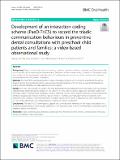Files in this item
Development of an interaction coding scheme (PaeD-TrICS) to record the triadic communication behaviours in preventive dental consultations with preschool child patients and families : a video-based observational study
Item metadata
| dc.contributor.author | Yuan, Siyang | |
| dc.contributor.author | Humphris, Gerry | |
| dc.contributor.author | MacPherson, Lorna | |
| dc.contributor.author | Ross, Al | |
| dc.contributor.author | Freeman, Ruth | |
| dc.date.accessioned | 2019-07-25T09:30:06Z | |
| dc.date.available | 2019-07-25T09:30:06Z | |
| dc.date.issued | 2019-07-24 | |
| dc.identifier | 260290595 | |
| dc.identifier | 2c20d2b9-5cb1-41f8-a45c-59221293deb6 | |
| dc.identifier | 000477040300003 | |
| dc.identifier | 85070507708 | |
| dc.identifier.citation | Yuan , S , Humphris , G , MacPherson , L , Ross , A & Freeman , R 2019 , ' Development of an interaction coding scheme (PaeD-TrICS) to record the triadic communication behaviours in preventive dental consultations with preschool child patients and families : a video-based observational study ' , BMC Oral Health , vol. 19 , 162 . https://doi.org/10.1186/s12903-019-0836-z | en |
| dc.identifier.issn | 1472-6831 | |
| dc.identifier.other | RIS: urn:2FD97497A8D4C3CB2E20342761F56503 | |
| dc.identifier.other | RIS: Yuan2019 | |
| dc.identifier.other | ORCID: /0000-0002-4601-8834/work/64033932 | |
| dc.identifier.uri | https://hdl.handle.net/10023/18163 | |
| dc.description | The research project is funded by the Scottish Government-Childsmile Programme. | en |
| dc.description.abstract | Background There is a paucity of research concerning paediatric dental consultations in primary care. This is potentially due to the difficulty of measuring the communication behaviours in the complex triadic consultations. The present study aims to describe the development and refinement of a coding scheme to record the triadic communication between dental professionals, child patients and parents. Methods The PaeD-TrICS was developed from video observation of triadic communications and refined through an iterative process. Its practical applicability was assessed via implementation of the scheme on specialised behavioural coding software. Reliability was calculated using Cohen’s Kappa. Results The PaeD-TrICS contains 45 codes. Forty-four dental professional-child-parent communications were successfully coded through administering the scheme on The Observer XT 10.5 system. Cohen’s Kappa was 0.83 (inter-coder) and 0.90 (intra-coder). “Parental verbal facilitation” (mean = 1.68/min) was the most frequent behaviour. Dental professionals’ “dentally engaging talk” (mean = 1.24/min), “praise” (mean = 1.10/min) and “instruction” (mean = 0.62/min) were frequently seen. Children’s common behaviours included “speech other” (mean = 0.66/min) and non-verbal behaviour i.e. “non-verbal agreement” and verbal behaviour “speech yes” (mean = 0.26/min). Conclusions The PaeD-TrICS is developed to capture the communication behaviour of the triadic consultations in a preventive dental setting. It demonstrates satisfactory intra- and inter-coder reliability and has been successfully used in paediatric dental consultations. | |
| dc.format.extent | 10 | |
| dc.format.extent | 1284937 | |
| dc.language.iso | eng | |
| dc.relation.ispartof | BMC Oral Health | en |
| dc.subject | Triadic communication | en |
| dc.subject | Behaviour coding scheme | en |
| dc.subject | Preschool children | en |
| dc.subject | Parent | en |
| dc.subject | Communication behaviour | en |
| dc.subject | Dental consultation | en |
| dc.subject | Video observation | en |
| dc.subject | RK Dentistry | en |
| dc.subject | RJ101 Child Health. Child health services | en |
| dc.subject | E-DAS | en |
| dc.subject.lcc | RK | en |
| dc.subject.lcc | RJ101 | en |
| dc.title | Development of an interaction coding scheme (PaeD-TrICS) to record the triadic communication behaviours in preventive dental consultations with preschool child patients and families : a video-based observational study | en |
| dc.type | Journal article | en |
| dc.contributor.institution | University of St Andrews. Sir James Mackenzie Institute for Early Diagnosis | en |
| dc.contributor.institution | University of St Andrews. Population and Behavioural Science Division | en |
| dc.contributor.institution | University of St Andrews. WHO Collaborating Centre for International Child & Adolescent Health Policy | en |
| dc.contributor.institution | University of St Andrews. Health Psychology | en |
| dc.contributor.institution | University of St Andrews. St Andrews Sustainability Institute | en |
| dc.contributor.institution | University of St Andrews. School of Medicine | en |
| dc.identifier.doi | 10.1186/s12903-019-0836-z | |
| dc.description.status | Peer reviewed | en |
This item appears in the following Collection(s)
Items in the St Andrews Research Repository are protected by copyright, with all rights reserved, unless otherwise indicated.

